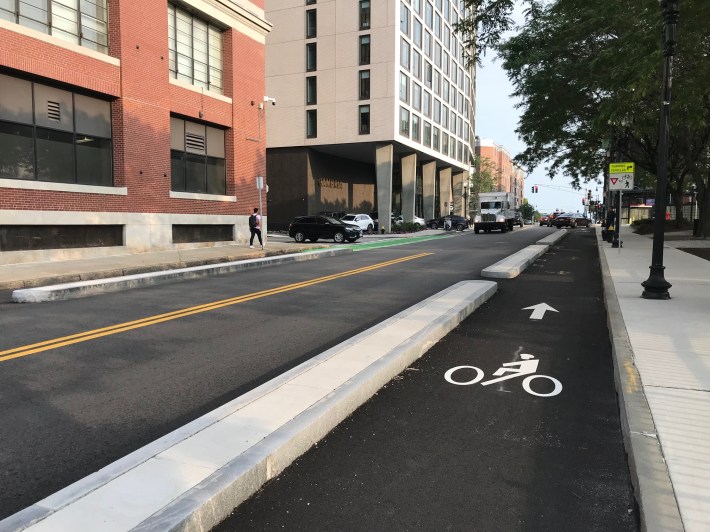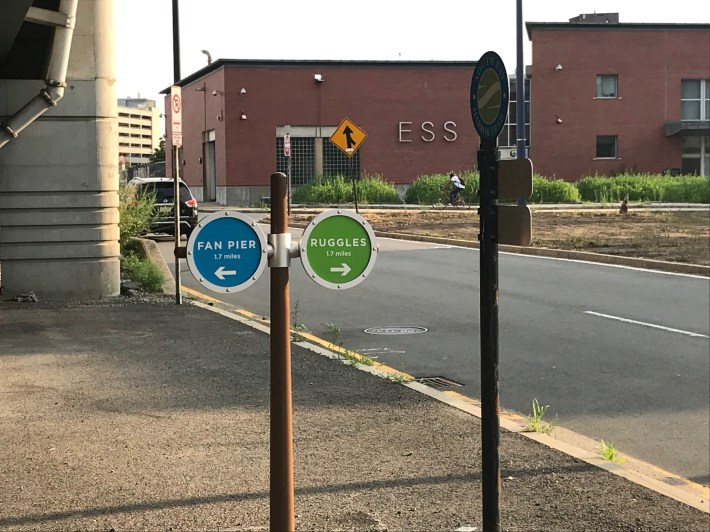The City of Boston and MassDOT are putting the finishing touches this month on a new link the the South Bay Harbor Trail, a proposed walk- and bike-friendly route that will eventually link the Harborwalk in the Seaport district to the Southwest Corridor park at the Ruggles Orange Line station.
The "phase one" segment currently under construction extends the existing shared-use path that exists along the Fort Point channel southward to Albany Street at the edge of the South End.
Notably, it brings a pair of flexpost-protected bike lanes across the Traveler/Broadway and W. 4th St. bridges, which span the MBTA's vast Cabot Yard and had been a significant gap in the city's network of bike routes. Riders heading east towards South Boston are guided onto the Traveler Street bridge towards Broadway, while westbound riders are guided onto the W. 4th St. bridge:

Unfortunately, the flexible post bollards - which were originally installed two weeks ago - lasted only a few days before they were vandalized:
These flexiposts on the Broadway bridge were intact Saturday morning. It's midday Sunday, and wow, already a mess. Even intact, the bike lane just ends without warning! It's a work in progress, but yikes! @maureencaught @SouthieBikes @EdforBoston @david_biele @nickcollinsma pic.twitter.com/0BxGEw3CS7
— Jill C (@Jill_A_C) July 18, 2021
A Boston Transportation Department official told StreetsblogMASS that the city was "reaching out to MassDOT to evaluate what happened and review our options moving forward."
On either side of the two bridges, the South Bay Harbor trail route benefits from more durable curbs that protect the route's new bike lanes. Here are a few more flattering photos of the project from last week, moving from the Fort Point Channel southward towards Albany Street in the South End:

At the intersection of Dorchester Ave. and Foundry Street, the southbound bike route shifts to the other side of the street:

At the eastern end of the Traveler St. Bridge, just beyond the remnants of destroyed flexposts pictured above, the project has widened the sidewalk and created a short section of curb-protected bikeway coming off of the bridge:

A block to the south, another new flexpost-protected bike lane on the westbound side of the W. 4th Street bridge complements the eastbound lane on Broadway (riders bound for South Boston can also take the new paint-only bike lane on the opposite eastbound side of W. 4th):

At the western end of both bridges, a new 2-way shared-use path brings the South Bay Harbor Trail another quarter-mile south, to Albany Street, underneath the soot-stained viaducts of Interstate 93.
This section of the trail offers a good example of why engineers need a broader context for designing "safe" bikeways. It checks off the requirements you might find in a modern design manual for bike infrastructure: it's well separated from traffic, accessible, and even has ornamental light fixtures.
But in actual experience, this segment of the South Bay Harbor Trail is noisy, polluted, and isolated, with a menacing aura from the fleet of police cars that loom just behind a tall chain link fence:

I rode it once for journalism, but next time I'm riding through the area, I'll take my chances mixing with traffic on one of the South End's friendlier parallel streets, like Harrison or Shawmut Avenue.

On a more positive note, the project includes some robust wayfinding signage, which is useful, because the official trail route includes lots of twists and turns:

A future project will extend the trail further south to Massachusetts Avenue, where it will connect to the existing Melnea Cass Boulevard path and complete the connection to Ruggles.






